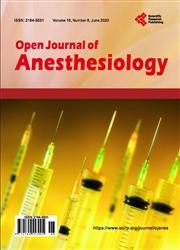Non-Operating Room Anesthesia and the COVID-19 Patient: Evidence Based Strategies
引用次数: 1
Abstract
As non-operating room anesthesia (NORA) vastly increases, so does the complexity of both the patients and the procedures. Unfamiliar environment, remote locations, and limited access to resources are some of the many challenges faced by the anesthesiologist in this environment. Understanding the environmental factors such as the room layout, machine placement and patient positioning needs advanced planning in the COVID-19 patient to determine airway management, intravenous access and overall patient safety. Communication with the proceduralist and healthcare workers (HCW) is of essence as both the procedure and anesthetic requirements may need to be altered as the case progresses. Standard monitoring guidelines should apply to all patients regardless of depth of anesthesia. The COVID-19 patient adds to these challenges. Aerosol generating medical procedures (AGMP’s) need to be identified ahead of time in order to ensure the safety of both the staff and patients. This allows for planning and preparation required for transportation of the patient to the room. HCWs may need to be identified and be available to assist with the procedure. Time should be allocated for transportation, briefing, room preparation, personal protective equipment needs of the staff and donning and doffing procedures as per institutional protocol. Communication means with staff outside of the room should be discussed in advance should an emergent situation arise during the procedure. Debriefing should be performed at the end of every procedure to improve patient safety and outcomes.非手术室麻醉与新冠肺炎患者:循证策略
随着非手术室麻醉(NORA)的大幅增加,患者和手术的复杂性也在增加。不熟悉的环境、偏远的地点和有限的资源获取是麻醉师在这种环境中面临的许多挑战之一。了解环境因素,如房间布局、机器放置和患者定位,需要对新冠肺炎患者进行高级规划,以确定气道管理、静脉通道和患者整体安全。与手术医生和医护人员(HCW)的沟通至关重要,因为随着病例的进展,手术和麻醉要求可能需要改变。标准监测指南应适用于所有患者,无论麻醉深度如何。新冠肺炎患者增加了这些挑战。产生气溶胶的医疗程序(AGMP)需要提前确定,以确保工作人员和患者的安全。这允许为将患者运送到房间所需的计划和准备。HCW可能需要被识别,并可用于协助该程序。应根据机构协议为运输、简报、房间准备、工作人员的个人防护设备需求以及穿脱程序分配时间。如果在手术过程中出现紧急情况,应提前讨论与室外工作人员的沟通方式。应在每次手术结束时进行汇报,以提高患者的安全性和结果。
本文章由计算机程序翻译,如有差异,请以英文原文为准。
求助全文
约1分钟内获得全文
求助全文

 求助内容:
求助内容: 应助结果提醒方式:
应助结果提醒方式:


